What's New
Displaying results 1941 - 1950 of 4052
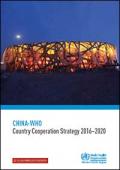
Resource | Publications,
The National Health and Family Planning Commission (NHFPC) of the People’s Republic of China and the World Health Organization (WHO) are pleased to present the China-WHO Country Cooperation Strategy 2016–2020, which provides a basis for collaboration on health between China and WHO over the next five years.
This country cooperation strategy (CCS) is the result of a consultative process involving the Government of China, WHO and major stakeholders. The strategy identifies priorities and approaches that will enable WHO to support China to strengthen the national health-care system and ensure that equitable, quality health services are delivered to the people. The strategy also aims to enrich China’s contribution to global health.

Resource | Publications,
In 2000, eight Millennium Development Goals (MDGs) were established and adopted by 189 heads of state in the United Nations Millennium Declaration. The target year for achievement of the MDGs was 2015. The MDGs led to important progress, but the initiative has been criticized for ignoring many aspects of development and focusing on aggregated rather than equitable achievement.
The WHO Western Pacific Region achieved all but two of the health related MDG targets, and made significant progress on the two that were not achieved. Clear disparities still remain among and between countries in the Region on health-related MDG indicators. Efforts will continue to achieve the unfinished MDG agenda and to address new or previously neglected health priorities included in the Sustainable Development Goals (SDGs) by 2030.
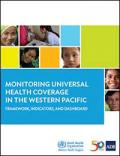
Resource | Publications,
The diversity of countries in the Western Pacific requires a flexible yet universal approach in order to meet national monitoring and evaluation (M&E) requirements. At the same time, this should allow for regional and global tracking and comparisons, as well as links with social information systems that conduct the required M&E for the SDGs.
To guide the monitoring of UHC progress and to make results more comparable within the region, the World Health Organization (WHO) Regional Office for the Western Pacific and the Asian Development Bank (ADB) are developing a regional monitoring framework and a proposed set of core indicators. The development of a regional universal health coverage (UHC) dashboard is also under way to visualize UHC indicators readily available from country information systems and from global databases. This will enable policy makers to make more evidence-informed decisions and the tool will also support countries’ need for better accountability.
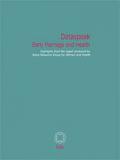
Resource | Publications,
Recent studies on early and child marriage in India emphasize that deep analysis of socioeconomic influences, including education, poverty and urbanization as well as cultural and social norms, is necessary to address the phenomenon. There is acknowledgement that early and child marriage have health linkages, but the research to date rarely extends beyond the consequences for maternal and infant health, thus excluding any comprehensive understanding of the impact of early marriage on other aspects of health.
The majority of efforts to address early and child marriage have been located outside the health system, despite its wide reach and its capacity to identify the implications of early marriage upon the health of girls and women.
Sama, a Delhi-based resource group working on issues of health and human rights, initiated research on current national data and strategies in India—including those aimed at young people—to
understand their implications for the health of women in early marriages.
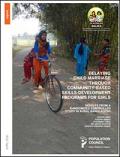
Resource | Publications,
Programs that elevate girls’ visibility and status in their families and communities, and build their skills and knowledge, have been shown to delay marriage in different parts of the world. However, in Bangladesh, where efforts to prevent child marriage have focused on the enforcement of laws and policies, little research exists on what approaches work best to delay marriage and why.
New research from Population Council shows that its Balika programme has significantly delayed child marriage and produced better health, educational and social outcomes for girls.
Girls who attended Balika’s weekly sessions were one third less likely to be married as children.The programme provides girls with education and skills for modern livelihoods as well as engaging their communities.
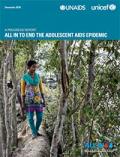
Resource | Publications,
UNICEF and UNAIDS launched the ALL IN platform in February 2015 to galvanize global action towards HIV and a population that were largely neglected in the global AIDS response – adolescents. The ALL IN initiative, with a focus on 25 lead countries that contribute to 86 per cent of all new HIV infections in adolescents, seeks to bring adolescents into focus in fast-track efforts to end the AIDS epidemic by 2030.
The purpose of the report is to showcase the significant contributions of many partners to research, innovations, community mobilization, programmes and policy actions aimed at ending the AIDS epidemic in adolescents in support of the ALL IN! agenda. UNICEF and UNAIDS acknowledge the regional and country office colleagues, national and implementing partners below for the ongoing work to support this global agenda and documented in this report, as well as for their support in the development of this report.
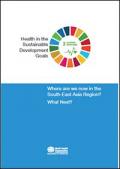
Resource | Publications,
The new Sustainable Development Agenda ‘Transforming Our World: the 2030 agenda for sustainable development’ was adopted by the UN General Assembly in September 2015. The 17 Sustainable Development Goals (SDGs) reflect a significant change in thinking about how to accelerate sustained improvements in development – in general and in health more specifically.
Health is centrally placed in the 2030 Agenda. The health goal (SDG3) is comprehensive: ‘to ensure healthy lives and promote well-being for all at all ages’. SDG3 builds on the significant success of the health-related Millennium Development Goals (MDGs). It recognizes an ‘unfinished MDG agenda’; it responds to new health priorities and increasing concerns about health security, and the health impact of migration and climate change. The SDG agenda recognizes that human health and well-being depend on the political, economic and social systems, and the natural environment, within which people live.
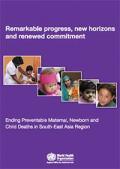
Resource | Publications,
In 1990, the South-East Asia Region had a very high maternal mortality ratio (MMR) of 525 per 100,000 live births, well above the global average of 385 and second only to the Africa Region. By 2015, the Region had attained an MMR of 164 which was well below the global average of 216. Despite the sharp reduction in MMR at 69% reduction, SEAR fell short of the MDG 5 mark.
It is however noteworthy, that SEAR registered the best progress made in MMR reduction among all the Regions in the MDGs era. Compared to a total of 210,000 maternal deaths in the 11 countries of the region in 1990, the region had 149,000 fewer maternal deaths in 2015 in comparison to 1990. The burden of maternal deaths in 2015 had plummeted to 61,000 – an unprecedented accomplishment in maternal survival in the history of South-East Asian countries.
The new vision of the SDGs and the new framework of the Global Strategy for Women’s, Children’s and Adolescents’ Health demand new thinking, new strategies and new tools to assist Member States.

Resource | Publications,
This report documents abuses suffered by a group of hijras, when they were forced to undergo so-called medical examinations at a hospital in Dhaka, the capital, in 2015, as part of a government employment program. The medical exams were ordered as part of the routine government hiring procedure, but absent a clear procedure to identify and respect hijras, hospital staff responded based on their own personal biases. Although a 2013 directive from the cabinet recognizes hijras as a third gender, the government has not developed rights-based procedures for changing their gender on official documents, leaving them open to abuse when they seek to assert their rights, Human Rights Watch found.
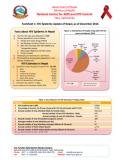
Resource | Fact Sheets,
- The first HIV case was detected in 1988.
- The key populations are as follows:
- People who inject drugs (PWID)
- Sex workers and their clients (Male and Female)
- Men who have Sex with Men (MSM) and transgender people
- Male Labor Migrants and their wives
- Prison Inmates
- Heterosexual transmission is dominant
- HIV prevalence among adult population in the country is below 1%





